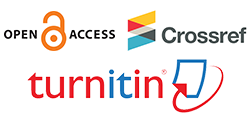Evaluación del bloqueo de los receptores dopaminérgicos d4 en el núcleo accumbens sobre la motivación por el alimento palatable
DOI:
https://doi.org/10.31644/IMASD.22.2020.a02Palabras clave:
Núcleo Accumbens Shell, Receptor D4 dopaminérgico, L-745,870, Motivación, Alimento palatableResumen
A nivel central, la regulación del procesamiento de la información de las propiedades motivacionales y reforzantes del alimento dependen principalmente de estructuras cerebrales como la Corteza del Núcleo Accumbens (CNA), donde la transmisión dopaminérgica juega un papel preponderante al activar receptores dopaminérgicos relacionados con el fenómeno de la recompensa. Estudios anatómicos y neuroquímicos indican que los receptores dopaminérgicos D4 (RD4) se encuentran de forma presináptica y regulan la liberación de glutamato hacia las neuronas GABAérgicas de la CNA. La presente investigación tuvo como objetivo estudiar los efectos del bloqueo farmacológico de los RD4 en la CNA sobre la regulación de la motivación por el alimento palatable (MAP) en ratas macho Sprague Dawley, utilizando un programa de reforzamiento de razón progresiva (PR). De acuerdo con nuestros resultados, el bloqueo de los RD4 con el antagonista L-745,870 (1 µg) en la CNA disminuye el número de palanqueos, el número de reforzadores obtenidos y los puntos de ruptura. Acorde a lo anterior, el bloqueo de los RD4 en la CNA disminuye la MAP, por lo cual podría ser un blanco farmacológico en el tratamiento de patología alimentaria al disminuir las propiedades reforzantes de los alimentos palatables.
Descargas
Citas
Bitner, R., Nikkel, A., Otte, S., Martino, B., Barlow, E., Bhatia, P., . . . Moreland, R. (2006). Dopamine D4 receptor signaling in the rat paraventricular hypothalamic nucleus: evidence of natural coupling involving immediate early gene induction and mitogen activated protein kinase phosphorylation. Neuropharmacology, 521–531.
Bonaventura, J., Quiroz, C., Cai, N.-S., Rubinstein, M., Tanda, G., & Ferré, S. (2017). Key role of the dopamine D4 receptor in the modulation of corticostriatal glutamatergic neurotransmission. Science Advances, 1–8.
Ducci, F., & Goldman, D. (2012). The genetic basis of addictive disorders. Psychiatric Clinics of North America, 35:495–519.
González, S., Rangel-Barajas, C., Pepper, M., Lorenzo, R., Moreno, E., Ciruela, F., . . . Ferré, S. (2012). Dopamine D4 receptor, but not the ADHD-associated D4.7 variant, forms functional heteromers with the dopamine D2S receptor in the brain. Molecular Psychiatry, 650–662.
Hajnal, A., Smith, G., & Norgren, R. (2004). Oral sucrose stimulation increases accumbens dopamine in the rat. American Journal of Physiology Regulatory Integrative Comparative Physiology, R31–37.
Huot, P., Johnston, T., Koprich, J., Espinosa, M., Reyes, M., Fox, S., & Brotchie, J. (2015). L-745,870 reduces the expression of abnormal involuntary movements in the 6-OHDA-lesioned rat. Behavior Pharmacology, 101–108.
Kelley, A., Baldo, B., Pratt, W., & Will, M. (2005). Corticostriatal-hypothalamic circuitry and food motivation: integration of energy, action and reward. Physiology and Behavior, 773–795.
Lindsley, C., & Hopkins, C. (2017). Return of D4 receptor antagonists in drug discovery. The Journal of Medicinal Chemistry, 1–11.
Missale, C., Nash, S., Robinson, S., Jaber, M., & Caron, M. (1998). Dopamine receptors: from structure to function. Physiology Review, 189–225.
Patel, S., Freedman, S., Chapman, K., Emms, F., Fletcher, A., Knowles, M., . . . Ragan, C. (1997). Biological profile of L-745,870, a selective antagonist with high affinity for the dopamine D4 receptor. Experimental Therapeutics, 636–647.
Paxinos, G., & Watson, C. (1998). The brain in stereotaxic coordinates. New York: Academic Press: 1998.
Reynolds, S.M., & Berridge, K.C. (2002). Positive and negative motivation in nucleus accumbens shell: bivalent rostrocaudal gradients for GABA-elicited eating, taste 'liking'/'disliking' reactions, place preference/avoidance, and fear. Journal of Neuroscience. 22, 7308–7320.
Richardson, N. & Roberts, D. (1996). Progressive ratio schedules in drug self-administration studies in rats: a method to evaluate reinforcing efficacy. Journal of Neuroscience Methods. 66, 1–11.
Stuber, G., & Wise, R. (2015). Lateral hypothalamic circuits for feeding and reward. Nature Neuroscience, 198–205.
Suyama, S., & Yada, T. (2018). New insight into GABAergic neurons in the hypothalamic feeding regulation. The Journal of Physiological Sciences, 717–722.
Svingos, L., PeriaSamy, S., & Pickel, M. (2000). Presynaptic Dopamine D4 Receptor Localization in the Rat Nucleus Accumbens Shell. Synapse, 222–232.
Tejas-Juárez, J., Cruz-Martínez, A., López-Alonso, V., García-Iglesias, B., Mancilla-Díaz, J., Floran-Garduño, B., & Escartín-Pérez, R. (2014). Stimulation of dopamine D4 receptors in the paraventricular nucleus of the hypothalamus of male rats induces hyperphagia: Involvement of glutamate. Physiology & Behavior, 272–281.
Thomas, T., Grandy, D., Gerhardt, G., & Glaser, P. (2009). Decreased dopamine D4 receptor expression increases extracellular glutamate and alters its regulation in mouse striatum. Neuropsychopharmacology, 436–445.
Zhang, M., Balmadrid, C., & Kelley, A. (2003). Nucleus Accumbens Opioid, GABAergic, and Dopaminergic Modulation of Palatable Food Motivation. Behavioral Neuroscience, 202–211.
























